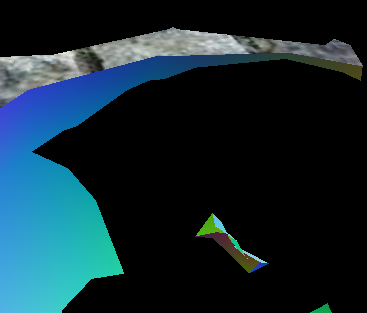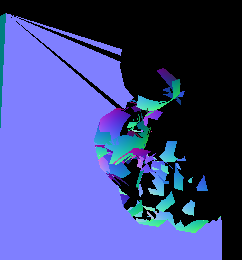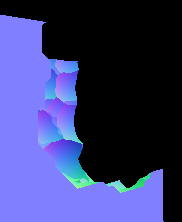It is much harder to get any bug now, 12,12 7,7 even 5,5 seems to provide very consistent results!
Basically, I didnt manage to get a single problem with 7,7.
And indeed, 5,5 seems a critical region, around out of 4 attempts (restarts of testM), one provides a bug face after many interactions:
the bug triangle seen from below

nothing seen from above

btw, around step 96, it already shows something:
sPositions.add( new Vector3f(0.27770352f,0.46122688f,0.51517385f)); // 1
sPositions.add( new Vector3f(0.27608168f,0.34551549f,0.06539202f)); // 2
sPositions.add( new Vector3f(0.52630138f,0.03579539f,0.02474916f)); // 3
sPositions.add( new Vector3f(0.20595354f,0.66981322f,0.42971194f)); // 4
sPositions.add( new Vector3f(0.18904364f,0.52505225f,0.93140197f)); // 5
sPositions.add( new Vector3f(0.97935265f,0.68711704f,0.48158187f)); // 6
sPositions.add( new Vector3f(0.48596126f,0.23843467f,0.93357599f)); // 7
sPositions.add( new Vector3f(0.01421112f,0.27380580f,0.19773597f)); // 8
sPositions.add( new Vector3f(0.71298790f,0.87922210f,0.51476270f)); // 9
sPositions.add( new Vector3f(0.79485250f,0.75485551f,0.99515438f)); // 10
sPositions.add( new Vector3f(0.77157128f,0.77839476f,0.05931848f)); // 11
sPositions.add( new Vector3f(0.33765650f,0.29436308f,0.59538013f)); // 12
sPositions.add( new Vector3f(0.64518267f,0.11867213f,0.96176815f)); // 13
sPositions.add( new Vector3f(0.24848801f,0.15109754f,0.61993992f)); // 14
sPositions.add( new Vector3f(0.45582271f,0.61759496f,0.86084294f)); // 15
sPositions.add( new Vector3f(0.80071312f,0.78237444f,0.29684871f)); // 16
sPositions.add( new Vector3f(0.32384932f,0.78567892f,0.68176097f)); // 17
sPositions.add( new Vector3f(0.88186044f,0.89698583f,0.38646924f)); // 18
sPositions.add( new Vector3f(0.31246120f,0.99689889f,0.60366225f)); // 19
sPositions.add( new Vector3f(0.69722843f,0.17010564f,0.40289277f)); // 20
sPositions.add( new Vector3f(0.56737870f,0.51288295f,0.00321507f)); // 21
sPositions.add( new Vector3f(0.82534564f,0.57062274f,0.28261465f)); // 22
sPositions.add( new Vector3f(0.37348580f,0.81682342f,0.67368442f)); // 23
sPositions.add( new Vector3f(0.66826415f,0.99113899f,0.97949696f)); // 24
sPositions.add( new Vector3f(0.22438675f,0.61881346f,0.43422037f)); // 25
sPositions.add( new Vector3f(0.25544399f,0.43739003f,0.49165052f)); // 26
sPositions.add( new Vector3f(0.87480676f,0.11029208f,0.22472137f)); // 27
sPositions.add( new Vector3f(0.89608353f,0.91551888f,0.23170120f)); // 28
sPositions.add( new Vector3f(0.33723837f,0.05473995f,0.15784162f)); // 29
sPositions.add( new Vector3f(0.60865152f,0.61520189f,0.97737426f)); // 30
sPositions.add( new Vector3f(0.14142460f,0.39914387f,0.24599236f)); // 31
sPositions.add( new Vector3f(0.22566748f,0.41332263f,0.00950694f)); // 32
sPositions.add( new Vector3f(0.15485024f,0.57639825f,0.70119578f)); // 33
sPositions.add( new Vector3f(0.05290598f,0.79258788f,0.22659695f)); // 34
sPositions.add( new Vector3f(0.10861605f,0.91088176f,0.68035346f)); // 35
sPositions.add( new Vector3f(0.04377919f,0.44823188f,0.15094322f)); // 36
sPositions.add( new Vector3f(0.68920767f,0.66604137f,0.94466478f)); // 37
sPositions.add( new Vector3f(0.04464799f,0.50060058f,0.37275547f)); // 38
sPositions.add( new Vector3f(0.62931901f,0.45162231f,0.35753506f)); // 39
sPositions.add( new Vector3f(0.65202111f,0.51006013f,0.78109592f)); // 40
sPositions.add( new Vector3f(0.68563026f,0.31424040f,0.61688083f)); // 41
sPositions.add( new Vector3f(0.08739573f,0.56442362f,0.07361543f)); // 42
sPositions.add( new Vector3f(0.02775884f,0.40120864f,0.25368088f)); // 43
sPositions.add( new Vector3f(0.42561126f,0.08508533f,0.52417850f)); // 44
sPositions.add( new Vector3f(0.93444425f,0.77615744f,0.98109519f)); // 45
sPositions.add( new Vector3f(0.92854166f,0.68288749f,0.46841764f)); // 46
sPositions.add( new Vector3f(0.37007278f,0.39217353f,0.14524925f)); // 47
sPositions.add( new Vector3f(0.14926779f,0.44578153f,0.17686743f)); // 48
sPositions.add( new Vector3f(0.87827176f,0.81727195f,0.18523437f)); // 49
sPositions.add( new Vector3f(0.11627805f,0.33141774f,0.59711856f)); // 50
sPositions.add( new Vector3f(0.02587420f,0.94024926f,0.71002156f)); // 51
sPositions.add( new Vector3f(0.44550377f,0.82438296f,0.62283421f)); // 52
sPositions.add( new Vector3f(0.72342467f,0.46676254f,0.39422596f)); // 53
sPositions.add( new Vector3f(0.92897040f,0.50566000f,0.61273122f)); // 54
sPositions.add( new Vector3f(0.47882491f,0.65437132f,0.83060253f)); // 55
sPositions.add( new Vector3f(0.27306068f,0.57173127f,0.13774878f)); // 56
sPositions.add( new Vector3f(0.42655313f,0.59532160f,0.31875283f)); // 57
sPositions.add( new Vector3f(0.38511860f,0.54043925f,0.47768301f)); // 58
sPositions.add( new Vector3f(0.24471194f,0.82192814f,0.48830944f)); // 59
sPositions.add( new Vector3f(0.67278528f,0.54504466f,0.09745085f)); // 60
sPositions.add( new Vector3f(0.35128516f,0.65485710f,0.61607915f)); // 61
sPositions.add( new Vector3f(0.15284234f,0.09497422f,0.11146510f)); // 62
sPositions.add( new Vector3f(0.70446914f,0.65306264f,0.58151633f)); // 63
sPositions.add( new Vector3f(0.60797894f,0.51344681f,0.92530870f)); // 64
sPositions.add( new Vector3f(0.34852356f,0.07145715f,0.17945975f)); // 65
sPositions.add( new Vector3f(0.37254894f,0.80542964f,0.88890177f)); // 66
sPositions.add( new Vector3f(0.73616028f,0.39821291f,0.06801569f)); // 67
sPositions.add( new Vector3f(0.20351452f,0.91303581f,0.72320229f)); // 68
sPositions.add( new Vector3f(0.95461959f,0.21565855f,0.91324383f)); // 69
sPositions.add( new Vector3f(0.46340734f,0.40685672f,0.19976103f)); // 70
sPositions.add( new Vector3f(0.11011094f,0.90722120f,0.49331629f)); // 71
sPositions.add( new Vector3f(0.48457295f,0.46555865f,0.85865045f)); // 72
sPositions.add( new Vector3f(0.19199139f,0.71535790f,0.86834544f)); // 73
sPositions.add( new Vector3f(0.04115498f,0.82713747f,0.42915702f)); // 74
sPositions.add( new Vector3f(0.61800349f,0.06707484f,0.62543017f)); // 75
sPositions.add( new Vector3f(0.88783878f,0.43486172f,0.12229562f)); // 76
sPositions.add( new Vector3f(0.63693637f,0.49088907f,0.79137754f)); // 77
sPositions.add( new Vector3f(0.87867749f,0.78637511f,0.14664972f)); // 78
sPositions.add( new Vector3f(0.05955619f,0.38885713f,0.14290255f)); // 79
sPositions.add( new Vector3f(0.13591242f,0.11856502f,0.32858527f)); // 80
sPositions.add( new Vector3f(0.45130950f,0.12749821f,0.22140574f)); // 81
sPositions.add( new Vector3f(0.99816906f,0.39879960f,0.67688763f)); // 82
sPositions.add( new Vector3f(0.27599066f,0.87235457f,0.10976708f)); // 83
sPositions.add( new Vector3f(0.28443813f,0.34108049f,0.17074001f)); // 84
sPositions.add( new Vector3f(0.59220099f,0.64068037f,0.29883301f)); // 85
sPositions.add( new Vector3f(0.21032435f,0.69509870f,0.22718686f)); // 86
sPositions.add( new Vector3f(0.96133840f,0.07793272f,0.98381025f)); // 87
sPositions.add( new Vector3f(0.86025840f,0.55727190f,0.13104689f)); // 88
sPositions.add( new Vector3f(0.47240525f,0.90199143f,0.77609187f)); // 89
sPositions.add( new Vector3f(0.78712440f,0.55742973f,0.76311892f)); // 90
sPositions.add( new Vector3f(0.61108696f,0.10808033f,0.72990811f)); // 91
sPositions.add( new Vector3f(0.48142982f,0.81970024f,0.52060682f)); // 92
sPositions.add( new Vector3f(0.67186862f,0.77876258f,0.23121035f)); // 93
sPositions.add( new Vector3f(0.15493429f,0.40537888f,0.23185605f)); // 94
sPositions.add( new Vector3f(0.58995610f,0.33311659f,0.00705606f)); // 95
sPositions.add( new Vector3f(0.39417428f,0.47937870f,0.61971760f)); // 96
sPositions.add( new Vector3f(0.54585254f,0.68676496f,0.87139761f)); // 97
sPositions.add( new Vector3f(0.06776696f,0.87885374f,0.14896846f)); // 98
sPositions.add( new Vector3f(0.37081677f,0.18404460f,0.54669964f)); // 99
sPositions.add( new Vector3f(0.17017645f,0.54999292f,0.11128503f)); // 100
sPositions.add( new Vector3f(0.56053740f,0.78079951f,0.30992448f)); // 101
sPositions.add( new Vector3f(0.32001537f,0.44523436f,0.08620554f)); // 102
sPositions.add( new Vector3f(0.76590687f,0.03684270f,0.59364378f)); // 103
sPositions.add( new Vector3f(0.80683553f,0.18522841f,0.85459214f)); // 104
sPositions.add( new Vector3f(0.15438688f,0.41930842f,0.33797449f)); // 105
sPositions.add( new Vector3f(0.69640076f,0.19685644f,0.05853683f)); // 106
sPositions.add( new Vector3f(0.73739821f,0.09245175f,0.41357023f)); // 107
sPositions.add( new Vector3f(0.57426214f,0.51166886f,0.70436966f)); // 108
sPositions.add( new Vector3f(0.78882986f,0.07467782f,0.57291675f)); // 109
sPositions.add( new Vector3f(0.15640312f,0.40672356f,0.02575749f)); // 110
sPositions.add( new Vector3f(0.73176700f,0.54052198f,0.32932806f)); // 111
sPositions.add( new Vector3f(0.80149478f,0.98603159f,0.81871510f)); // 112
sPositions.add( new Vector3f(0.45161510f,0.24455494f,0.32157898f)); // 113
sPositions.add( new Vector3f(0.69247639f,0.65278059f,0.74903792f)); // 114
sPositions.add( new Vector3f(0.57290655f,0.11720842f,0.89983869f)); // 115
sPositions.add( new Vector3f(0.02047265f,0.66252160f,0.35670352f)); // 116
sPositions.add( new Vector3f(0.21933514f,0.60925192f,0.47442764f)); // 117
sPositions.add( new Vector3f(0.47672379f,0.40354192f,0.61204731f)); // 118
sPositions.add( new Vector3f(0.71098053f,0.22188783f,0.74071270f)); // 119
sPositions.add( new Vector3f(0.35400301f,0.96791077f,0.88958502f)); // 120
sPositions.add( new Vector3f(0.00277239f,0.11852777f,0.46382076f)); // 121
sPositions.add( new Vector3f(0.76961392f,0.95164806f,0.00021791f)); // 122
sPositions.add( new Vector3f(0.04299396f,0.94793499f,0.06643200f)); // 123

 (Also many thanks to the original author, if you read this)
(Also many thanks to the original author, if you read this)






